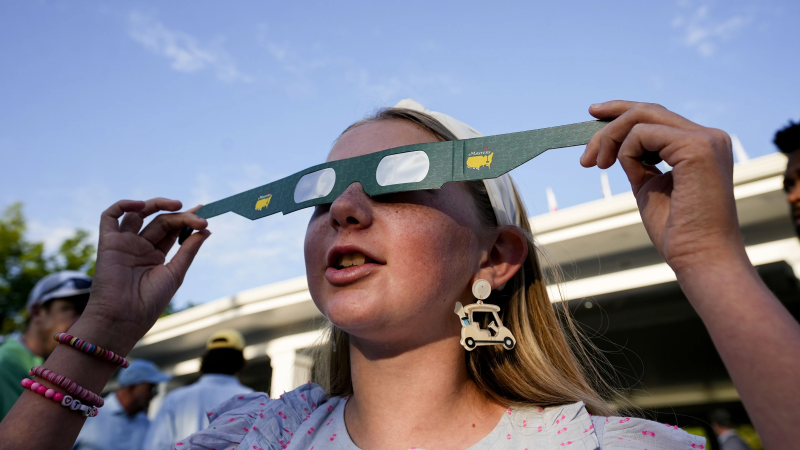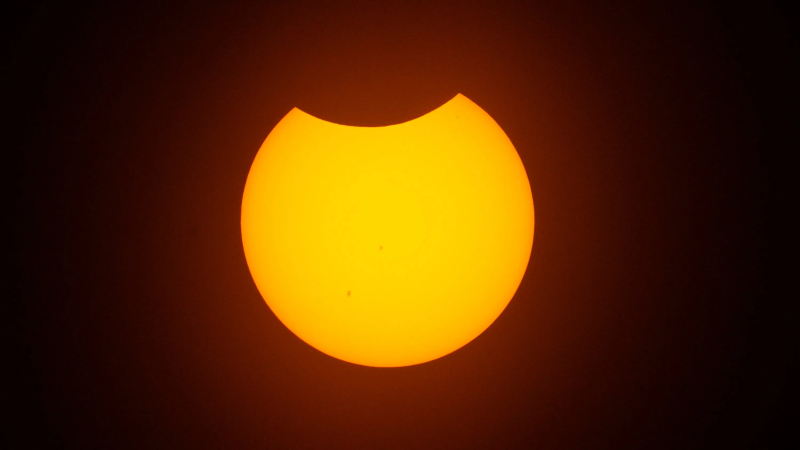Solar eclipse 2024 live updates: See latest weather forecast, what time it hits your area
It's finally here.
After years of buildup and anticipation, the Great North American Eclipse will occur today: This afternoon, a total eclipse of the sun will appear in the skies above the U.S., all the way from southern Texas to northern Maine.
The rare event − where the shadow of the moon plunges a narrow strip of land into darkness in the middle of the day − is an astronomical experience like no other that will be unusually accessible to millions of people.
That is, if the weather cooperates. Here are all the details and the latest forecast:
What time is the 2024 solar eclipse?
The total eclipse will begin in Mexico at about 11:07 a.m. PDT, Monday before crossing into Texas at 1:27 p.m. CDT. It will end in Maine at 3:35 p.m. EDT. The partial eclipse will last for awhile longer. Even if you're not in the path of totality and won't see the full eclipse, you may still see a percentage of it.
To find out exactly when the eclipse will be happening in your area, you can search by USA TODAY's database by ZIP code for a viewing guide.
Eclipse weather forecast: Where will there be clear skies?
Surprisingly, weatherwise, the best spot for viewing the eclipse today is expected to be northern New England, specifically northern portions of Maine, New Hampshire and Vermont, according to the Weather Prediction Center.
Skywatchers in northern Maine were celebrating Monday morning, as clear skies were reported across the state. "Viewing conditions look excellent," the weather service in Caribou, Maine, said. In northern Vermont, an approaching deck of clouds was keeping both eclipse chasers and meteorologists on edge: "It willbe a close one in regards to eclipse viewing," the weather service in Burlington, Vermont, reported Monday morning.
Elsewhere, clear skies are also "possible" from northern Arkansas to central Indiana, the weather service said, but the potential for high clouds could impact the view there.
Where will it be cloudy or stormy for the eclipse?
As predicted, skies were cloudy across much of central and southern Texas on Monday morning, a precursor to some potentially severe weather that could rumble across the state later in the day, forecasters said. Monday morning, both San Antonio and Austin reported overcast skies, while Dallas-Fort Worth had mostly cloudy skies, according to the National Weather Service.
"A high probability of poor eclipse viewing conditions continues for nearly all of South-Central Texas for midday today," the weather service said.
Farther north, folks in big cities in the path of totality such as Indianapolis and Cleveland were anxiously hanging on every forecast update. In Indianapolis, the forecast looked good: Only some scattered high clouds were expected during the eclipse. Weather service meteorologist Joseph Nield said, "We're cautiously optimistic that things are looking pretty good for us."
In Cleveland, unwelcome light rain was reported Monday morning, but improving weather and partly sunny skies were predicted for eclipse time.
Poor viewing conditions also were expected from Missouri and Kansas, AccuWeather said. Weather.com said areas with the highest chance of rain include parts of Louisiana, Mississippi and Tennessee. The Weather Prediction Center said clouds may also impede viewing across Ohio, northwest Pennsylvania and parts of New York.
"Multiple rounds of severe thunderstorms should develop from early afternoon Monday through Tuesday morning across a large portion of Texas, into south Oklahoma, southwest Arkansas, and west Louisiana," the Storm Prediction Center said. "A few tornadoes, scattered large to very large hail, and isolated severe wind gusts will be possible."
Hundreds of thousands expected to watch in southern Illinois
CARBONDALE, Ill. – Southern Illinois University-Carbondale officials expect 200,000 to 300,000 people to flood southern Illinois today for viewing in the path of totality, and a projected 50,000 in Carbondale – roughly double the town's population. Michelle Nichols, director of public observing at Adler Planetarium, will co-host an eclipse show in Saluki Stadium.
"Thousands of people are here today to see this eclipse, feel the temperature drop and feel the overall excitement and hear the reactions of everyone around them," she said. "This is a multi-sensory experience involving the sun, the moon, and you. It involves one single action: Looking up."
−Dave Eminian, Peoria Journal Star
Clear skies, high hopes in Vermont
ST. JOHNSBURY, Vt. − Out of state plates vastly outnumbered Vermonters near the state border with New Hampshire Monday morning. Connecticut was well-represented, followed by Massachusetts, New York, Rhode Island and New Jersey. Interstate 91 was clear sailing, but I-93, which comes up from the Boston area was already quite congested before 10 a.m. Skies were uncharacteristically crystal clear for this time of year and though it’s called “mud season,” none was evident and only a few traces of recent snow fall.
In St. Johnsbury, population 7,300, more than 100 people were already lined up at the doors of the 135-year-old Fairbanks Museum and Planetarium waiting for the first astronomy program of the morning. Dozens more set up lawn chairs, blankets and cameras in the churchyard across the street.
− Karen Weintraub
What is the difference between a solar eclipse and a lunar eclipse?
A total solar eclipse occurs when the moon comes in between the Earth and the sun, blocking its light from reaching our planet, leading to a period of darkness lasting several minutes. A total lunar eclipse occurs when the moon and the sun are on exact opposite sides of Earth. The Earth blocks the sunlight that normally reaches the moon. Instead of that sunlight hitting the moon’s surface, Earth's shadow falls on it.
A lunar eclipse can last for a few hours, while a solar eclipse lasts only a few minutes. Solar eclipses also rarely occur, while lunar eclipses are comparatively more frequent. While at least two partial lunar eclipses happen every year, total lunar eclipses are still rare, NASA says. Another major difference: No special glasses or gizmos are needed to view the a lunar eclipse, and people can directly stare at the moon.
− Saman Shafiq

Solar eclipse, lunar eclipse:What is the difference?
Can you drive during the solar eclipse?
The 2024 solar eclipse will shroud much of the United States in darkness on Monday, leaving many people to wonder: Is it safe to drive during the solar eclipse?
It is safe to drive during an eclipse as long as you don't look up at the sky. AAA is telling drivers to be focused on the road if they are operating a car during the total solar eclipse. But the automobile insurance company is advising Americans who want to safely view the total eclipse to "find a safe place to park (not on the side of a road or highway) away from other traffic and then wear your eclipse glasses," said Aixa Diaz, a spokeswoman from AAA.
"Pack your patience, whether traveling a great distance or locally," Diaz said. "People will be out and about to catch a glimpse of the eclipse."
A similar scenario played out in 2017 during the nation's last total solar eclipse: Congestion in some areas lasted for up to 13 hours after totality, according to Transportation Research News, a National Research Council publication. An analysis of traffic patterns from that year suggests the worst of the traffic – on interstates and rural back roads alike – will kick off after the eclipse ends and everyone tries to leave all at once.
− Kayla Jimenez
When will the next solar eclipse happen?
It will be 20 years before there's a chance to witness a total solar eclipse in the United States again. According to NASA, after Monday's total solar eclipse, the next one viewable from the contiguous U.S. will be on Aug. 23, 2044.
Unfortunately, the 2044 total solar eclipse won't have the broad reach across the U.S. as the 2024 eclipse. The path of totality during the 2044 eclipse will only touch three states, according to the Planetary Society, a nonprofit involved in research, public outreach and political space advocacy. The eclipse will begin in Greenland, sweep through Canada and end around sunset in Montana, North Dakota and South Dakota.
But another eclipse scheduledfor Saturday, Aug. 12, 2045, will trace a path of totality over California, Nevada, Utah, Colorado, New Mexico, Oklahoma, Kansas, Texas, Arkansas, Missouri, Mississippi, Louisiana, Alabama, Florida and Georgia.
− Mary Walrath-Holdridge, Gabe Hauari and Eric Lagatta

Eclipse and pets: It's not the sky that's the problem
An eclipse itself isn't dangerous for domestic animals such as dogs and cats, but experts say it's probably best to not bring pets to experience the April 2024 total solar eclipse. Experts' biggest concern is not what’s happening in the sky but on the ground as crowds of excited and eager people gather, said Dr. Rena Carlson, president of the American Veterinary Medical Association. Dogs especially will take their cues from their owners rather than the celestial event.
“Rather than the effects of the eclipse, I would be more worried about the excitement and all of the people,” Carlson said.
− Elizabeth Weise
A guide to the solar eclipse for kids
Here's an easy-to read, illustrated guide to help kids understand what the April 8 total solar eclipse means, where it will be visible and how you can watch it safely. It also shows them how an ordinary kitchen colander can easily be used to view a solar eclipse − the colander's holes can project crescent images of the sun onto the ground. There are even pages that can be downloaded and colored.
Trump's eclipse experience lit up internet in 2017
Seven years ago, when the last total solar eclipse crossed over North America, a photo of then-President Donald Trump seemingly gazing at the sun with his naked eyes set the internet ablaze. During the afternoon of Aug. 21, 2017, Trump, who was president at the time, was joined by then first lady Melania Trump and their son Barron to watch the rare phenomenon from the Truman Balcony at the White House. Photos taken by members of the media captured all three donning eclipse glasses while looking at the eclipse.
But at one point during the viewing, the former president was captured in photos and videos without proper eye protection, seemingly gazing directly at the sun. Looking at an eclipse before or after the brief phase of totality without proper eyewear can lead to eye damage.
− Natalie Neysa Alund
When is the next total solar eclipse?What to know about the next eclipse's path, timing

How to make a solar eclipse viewer
People who didn't manage to get their hands on glasses are not completely down and out. There are other safe ways to view the eclipse, say experts, and a lot of them only require a little bit of craftiness and items you can find lying around the house.
Steps to make the cereal box eclipse viewer (And here is a video aid):
- Get an empty, clean cereal box.
- Cut a white piece of cardboard that will fit snuggly in the bottom of the box, or secure it permanently by gluing it in place.
- Cut the top of the cereal box, removing both ends and leaving the center intact.
- Put a piece of tape across the center of the top to securely hold it closed.
- Tape a piece of heavy-duty foil or double a single layer for additional strength, covering one of the openings at the top of the cereal box. The other opening will remain open for viewing.
- Using a small nail (approximately 3mm in diameter) push a hole in the foil.
- Cover the entire box with construction paper, leaving the single-viewing opening and the foil uncovered.
The finished box should be held with the pin-hole side facing the sun. It may take a little practice pointing the box. With your back facing the sun, look through the viewing opening. A small image of the sun, about ½ cm in diameter, can be seen projected on the white paper inside the box.
− Mary Walrath-Holdrid
What is the path of the solar eclipse called?
Those in the direct line of the eclipse will be treated to an incredible sight as the moon completely blots out the sun's disk, ushering in uncharacteristic darkness and revealing the sun's elusive outermost layer called the corona. That moment is called "totality" and this year the path of totality crosses through 13 U.S. states.
The last total solar eclipse to cut through North America was in August 2017.
How to look at eclipse without glasses
A total solar eclipse offers skygazers the rare opportunity to witness the eclipse with the naked eye. However, solar eclipse glasses are still needed until totality is reached.
Certified solar eclipse glasses are crucial for spectators to avoid the sun's retina-damaging rays. But when the moon moves completely in front of the sun and blocks its light, you'll know it's safe to remove the glasses for a short period of time.
How fast does an eclipse shadow travel?
According to a post from the National Weather Service in Indianapolis on X, an eclipse shadow travels at speeds from 1,100 to 5,000 mph. Near the equator, it travels at around 1,100 mph and increases in speed as it approaches the poles.
The eclipse party is over? Time to recycle those glasses!
Astronomers Without Borders, or AWB, a non-profit organization running its second nationwide eclipse glasses recycling drive. Her business will join over 300 schools, museums, city governments, commercial businesses, community organizations and local libraries that will collect and ship an estimated millions of glasses to be repurposed for use by underserved communities around the world in future solar eclipses.
AWB launched its first run of the program after the last solar eclipse in 2017 when volunteer centers across the country collected millions of the glass. After vetting them for reuse, more than half a million glasses were distributed to Africa, Asia and South America.
People can visit AWB's website to find their nearest participating collection center and learn more about recycling the glasses, said Andrew Fazekas, the organization's communication manager.
"We figure there's probably going to be tens of millions of glasses out there at the very least," he said. "And most of them are probably very gently used."
− Cybele Mayes-Osterman
Disclaimer: The copyright of this article belongs to the original author. Reposting this article is solely for the purpose of information dissemination and does not constitute any investment advice. If there is any infringement, please contact us immediately. We will make corrections or deletions as necessary. Thank you.




